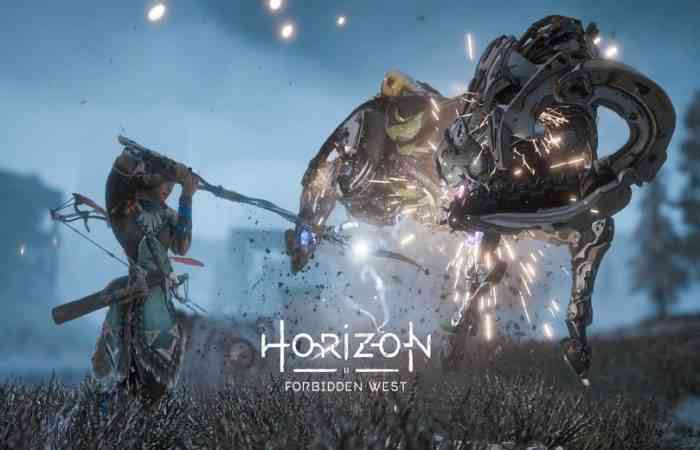Horizon Forbidden West Review
*This review contains no spoilers for Horizon Forbidden West, and tags any Horizon Zero Dawn spoilers as such*
Horizon Zero Dawn is one of the best loved new IPs from the PlayStation 4 era, having recently crossed 20 million sales and cementing Guerrilla Games as one of Sony’s heavy hitters. With dynamic gameplay and a compelling fusion of fantasy and science fiction, it’s no surprise that Horizon Forbidden West continues the journey of series heroine Aloy. And continuing is very much what Forbidden West is going for. It doesn’t rewrite the book or overhaul the gameplay, but it makes smart enhancements that make it a richer, more interesting experience that leans equally on its characters, story, world design, and mechanics. Journeying into the Forbidden West is a fantastic undertaking that’s well worth the time and effort.
*Horizon Zero Dawn spoilers in the next paragraph. Scroll down to “To be clear” for the end of the spoilers*
At the end of Horizon Zero Dawn, Aloy defeats the rogue HADES AI, stopping it from reactivating the Faro Plague that nearly wiped the Earth clean a thousand years in the past. The immediate threat quelled, Aloy seeks out the last resting place of Elisobet Sobeck, the Zero Dawn creator with whom she shares her genetic code. In a foreboding after credit scene, we discover that Sylens has captured HADES for his own purposes, telling the AI they have things to discuss. With GAIA destroyed and the biosphere at great risk of collapse, Aloy sets out to repair the existing damage and ensure the future viability of the Earth. That’s the bare minimum of what you’ll likely want to remember from Horizon Zero Dawn, as there are links to Aloy’s past exploits all over the place in Forbidden West.
To be clear, you should really play and complete Zero Dawn before playing Forbidden West. It’s a direct continuation of the story, and big parts of the narrative won’t have the intended impact if you don’t know what’s going on. Even those of you who’ve played the original game are going to want to watch a recap video before you get going – I know I had to pause and take a minute to remember things.
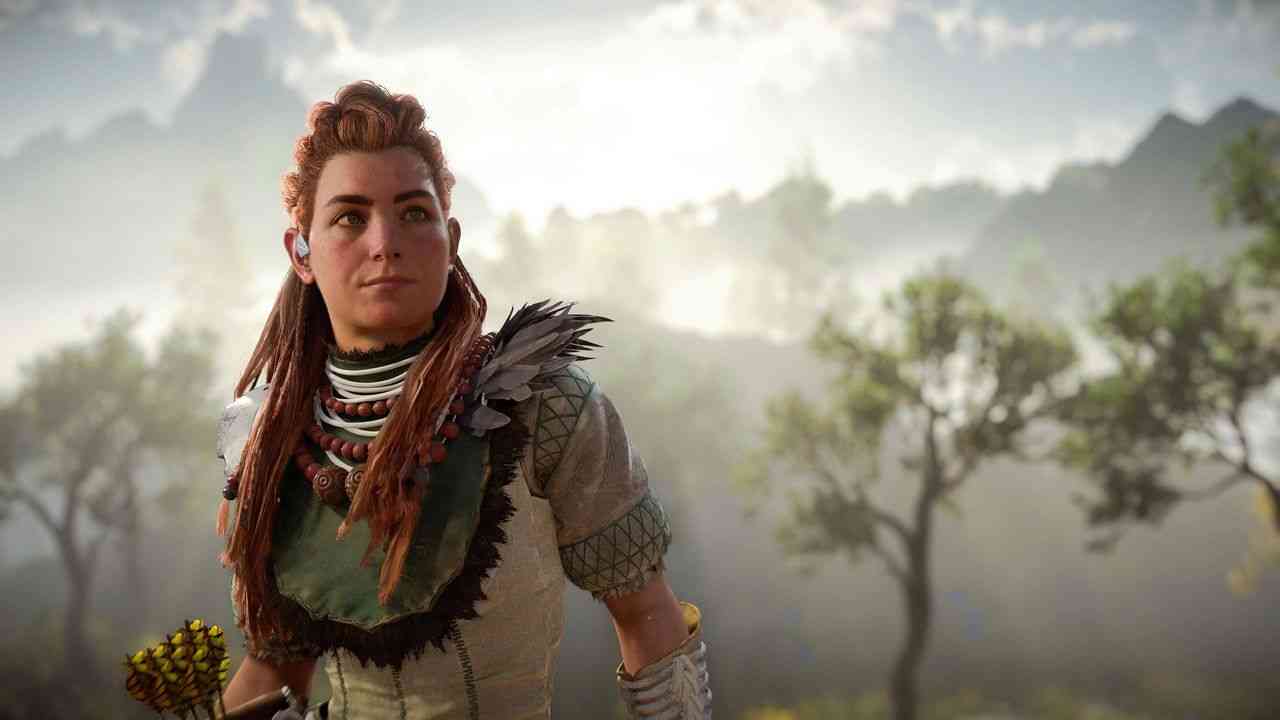
Without giving anything away, Horizon Forbidden West sees Aloy journeying west to rebuild GAIA and literally save the world. No pressure, right? Along the way there are countless great character moments, both with returning faces like Varl and Erend, and brand new ones like Alva, Kotallo, and Chief Hekarro. The team at Guerrilla has done an outstanding job of bringing familiarity to Forbidden West while also focusing their attention on new and exciting ideas. Much like Zero Dawn revolved around the ideas of and interactions between groups, Forbidden West weaves the web of interaction much tighter. What you thought you knew isn’t always based on perfect information. Of particular note is how the writing handles the culture and traditions of the various tribes such as the Tenakth and Utaru. In a world where subtlety in popular culture writing is distressingly rare, Forbidden West was a treat. There’s a massively diverse cast of characters who interact and grow through earned respect. Perhaps most importantly, the focus is on creating an engrossing world from the interactions that diversity creates.
How many times have you played an RPG and only explored side conversations in service of completion? Horizon Forbidden West is packed full of lore, side conversations, and revelations about the world, and I wanted to hear, read, and observe everything. I never found myself wishing a character would stop talking, or wanted to button through a conversation, at least in the more prominent stories.
A good deal of the jobs and errands in the game are very much that. Bring back this person, find this thing, kill this machine. They come as an expected part of this genre, but essentially the mechanical side of the game makes even those less story driven pieces worth doing.
Many times I’d find myself getting completely into the weeds of hunting collectibles or helping one of the tribes out. Crucially though, it doesn’t go too far. Where I’ve found myself getting tired of the game in other action RPGs because of my completionist nature, Forbidden West avoids that fate by providing mysteries I desperately wanted the answers to. So for every Tall Neck I ran 5km to, there were equally as many times I ignored those activities in favor of continuing the main tale.
A big part of the reason for that is Aloy herself.

The Burden of Being Important
Aloy always felt like a paradox. She’s principled and extremely morally driven, endlessly willing to do what’s necessary based on her view of what’s right. But equally, she’s incredibly uncomfortable with the responsibility that’s been thrust upon her. The warmth of her heart isn’t easy to see, being shrouded by a cold, analytical exterior. Close relationships are difficult for her to establish. Aloy struggles to tell the people she cares about how she feels. In Forbidden West, she continues to be a fascinating character very well acted by Ashly Burch.
Horizon Forbidden West does a brilliant job of exploring Aloy as a character, giving her a platform for character growth. Everything we know about her, and everything she thought she knew about herself is directly challenged. The story itself is a mirror of sorts, forcing Aloy to examine her own perspectives. Faced with both changes and challenges, watching and participating in Aloy’s grandiose and yet somehow delicately told story is an absolute pleasure.
The world provides copious amounts of fuel for Aloy and the other characters to work with. There’s an incredible diversity of landscapes to be explored, smoothly covering most of the North American west with believable transitions. All the video game staples are of course here: snowy mountains, alpine forests, temperate rainforests, deserts, and more. Each has immense character, and often directly affects gameplay. Taking on a pack of Bristlebacks in the jungle or a snowy field are two completely different parties. The common thread is that each region feels like a real place with elements existing where you’d expect them to in reality. Believable world design and construction are far from an expectation in games, and Horizon Forbidden West has one of the most tantalizing worlds I’ve encountered.

Throughout all those landscapes are remnants of the past. Structures left behind by the old ones often have much more to them than you see or the surface. Equally common are places where there’s no information to be found and the environmental storytelling lets your imagination run free. It’s a fantastic balance of showing and telling.
Getting around the world is an organic experience. I recommend playing in the explorer mode, which limits the number of breadcrumb trails you’ll be following to the bare minimum. Though not as seamlessly refined as Ghost of Tsushima’s gusts of wind, there are few reasons to visit Forbidden West’s map screen. It’s far more engaging to simply point Aloy in the direction of her objective, and let the world design tell you how to get there.
There’s of course the option to adjust things to suit your taste. But Forbidden West continues Zero Dawn’s minimal UI concept, and is designed to match that. It makes the world a more interesting place when you can just explore instead of needing to pull up the map all the time.

Getting Around
Traversal isn’t nearly as seamless and formless as in Breath of the Wild though. Aloy can only climb certain areas of rock faces, even when they look similarly scaleable. Skyrimming (it’s a word) up a mountain in a way the game doesn’t expect occasionally leads to invisible walls. You’d think that would be annoying, but it barely registered for me. Of all the Horizon series’ goals, traversal would be less important than almost anything else I’m covering in this review.
In lots of places, that leads to a fair bit of what I lovingly refer to as “open world jank”. Aloy can fail to step over surfaces that look mostly flat, or refuse to pull herself up onto a ledge that looks like many others. Other times her feet or hair will clip through objects, and these moments do remind you that you’re playing a game. But as I’ve alluded to, this franchise is less concerned with the act of going from A to B, and infinitely more interested in what happens along the way and once you’ve arrived. It’s a different approach than many competitors, and one that ultimately works really well.
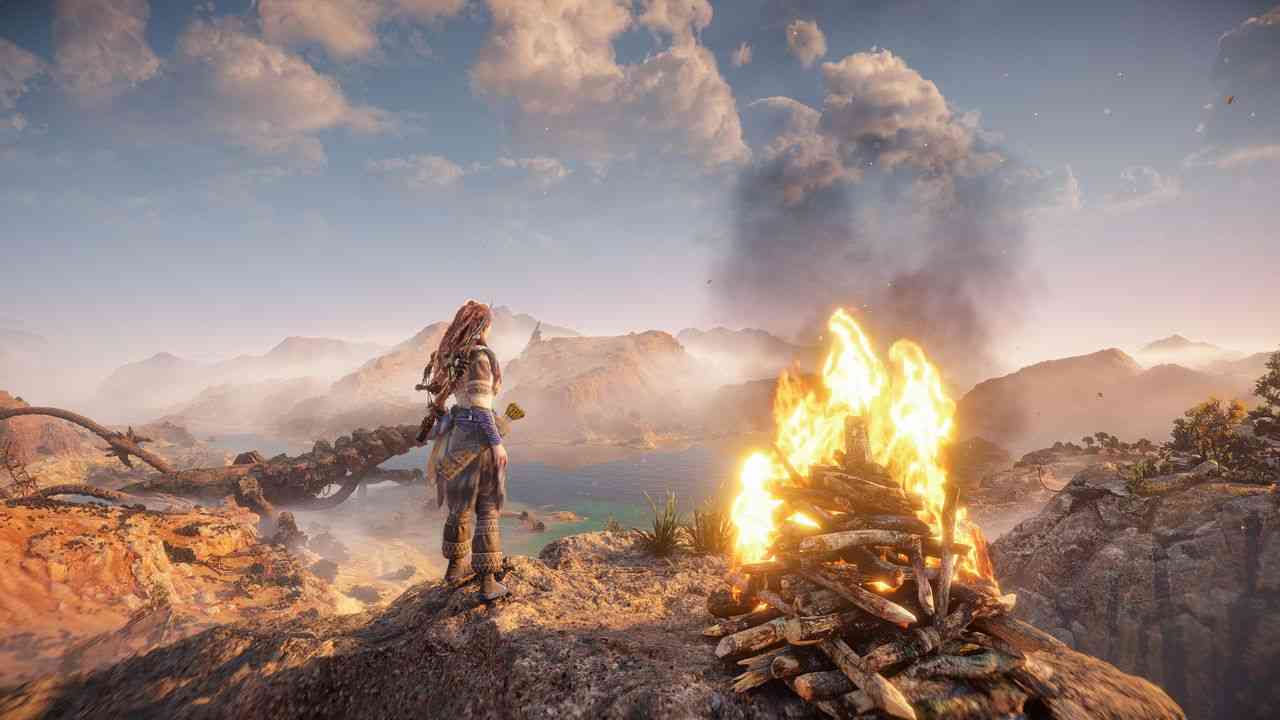
It does have multiple similarities to other open world adventures though, and throughout my 50 hours with the game I found myself most often comparing it to the latest series of Tomb Raider games. Like Lara, Aloy gathers gadgets and tools as she goes, and outside of a few game changing mechanics – like the shield wing glider and the ability to stay underwater for longer – they’re more about gating areas than changing how you play. It’s a Metroid-lite approach, and it works very well. I indeed felt compelled to return to areas many times not just for missions, but because I now had a tool that’d let me explore a relic ruin or other facility.
Under the category of “more”, we most prominently find gear, crafting, and skills. These mechanics haven’t substantially changed from Zero Dawn, but there’s a heck of a lot more to them. Where there were a handful of outfits in Zero Dawn there are dozens in Forbidden West, each with unique tradeoffs, upgrade paths, and associated ways of playing.
The skill tree has expanded more clearly encompassing Aloy’s array of skills, and includes a lot more choice in the process. Instead of treating them as a checklist I knew I’d eventually complete, I found myself rushing toward certain skills in certain trees, because I wanted to play a certain way. A vast array of weapon skills have been added to what was available in the last game, and most exciting is the new Valor Surge. It’s essentially a super that builds up over time, and can turn the tide of battle in an instant. A special potion that causes constant health regen was particularly useful in close quarters combat, while a surge that massively increases ranged damage for a few shots was extremely useful against enemies with particularly vulnerable weak points.
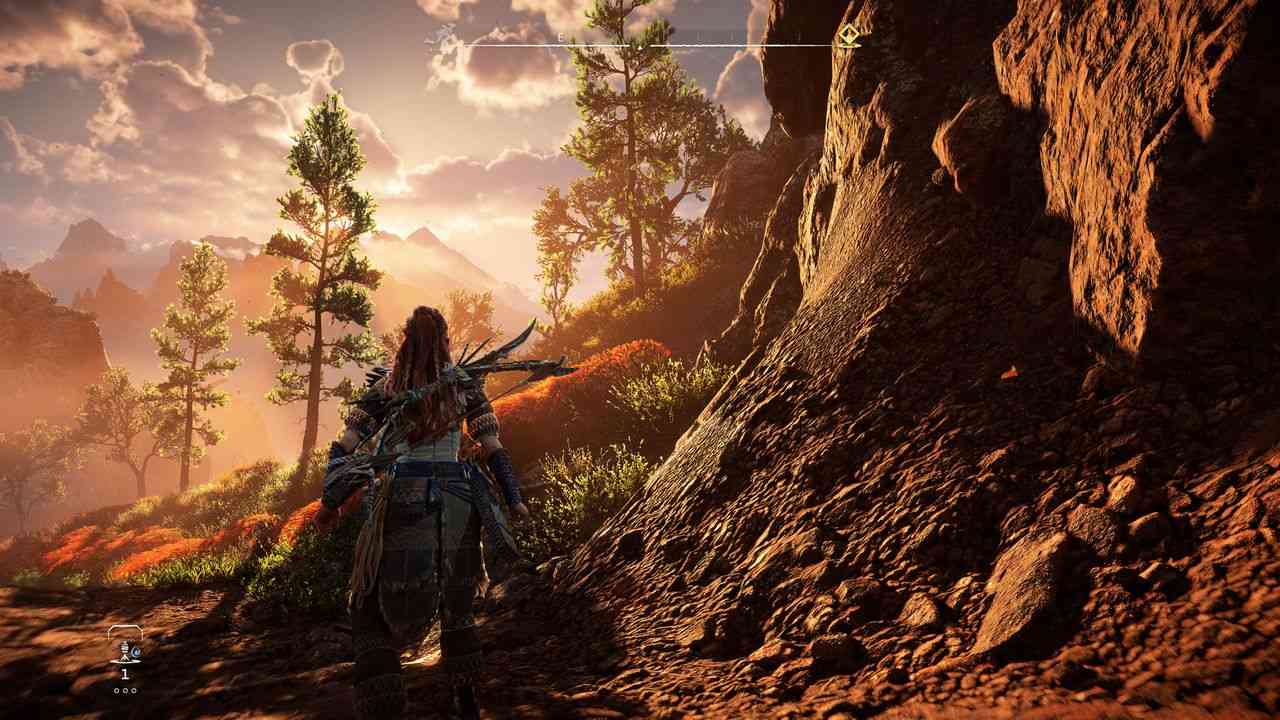
That variety extends to weapons and elemental damage types too, with an absolute slot machine of different setups to consider. I tended to favor Hunter Bows, filling out my weapon wheel with options for dealing fire, ice, shock, acid, tear, and plasma damage (among other traits!), and the amazing thing is I could have ignored all those options. It would be possible – and fun – to replay Forbidden west with a completely different approach, working primarily with slings, or warrior bows, or shredders, or javelins. There are a ton of options, and though I focused in one direction the strategies are all equally interesting to play around with.
You see where I’m going with this, right? Horizon Forbidden West’s combat is phenomenal, and a massive upgrade over the already excellent Zero Dawn. It’s extremely tactical in nature, and on harder difficulties it’s absolutely necessary to engage with those weaknesses. I found myself changing outfits and loadouts for specific creatures and encounters, setting up traps, and even planning escape routes before tougher battles. It leads to an extreme amount of satisfaction when everything falls into place and you detonate a canister on a machine causing a chain reaction, or you detach a key resource you desperately need from a rare machine. With practice, hunting in Horizon Forbidden West is supremely satisfying.
All that might get boring eventually, if not for the vast array of different machines to take on. Plenty of them are returning favorites like the Thunderjaw, Fireclaw, and Stormbird. Even though I’d tackled those foes before, experimenting with new weapons and the strategies they enable was incredibly fun.
The new additions are great too: the Leaplasher, Tideripper, and Tremortusk to name a few. It continues the unique structures that made Zero Dawn’s machines so engaging – machines are consistently clearly identifiable and related to something real, but at the same time completely unfamiliar.
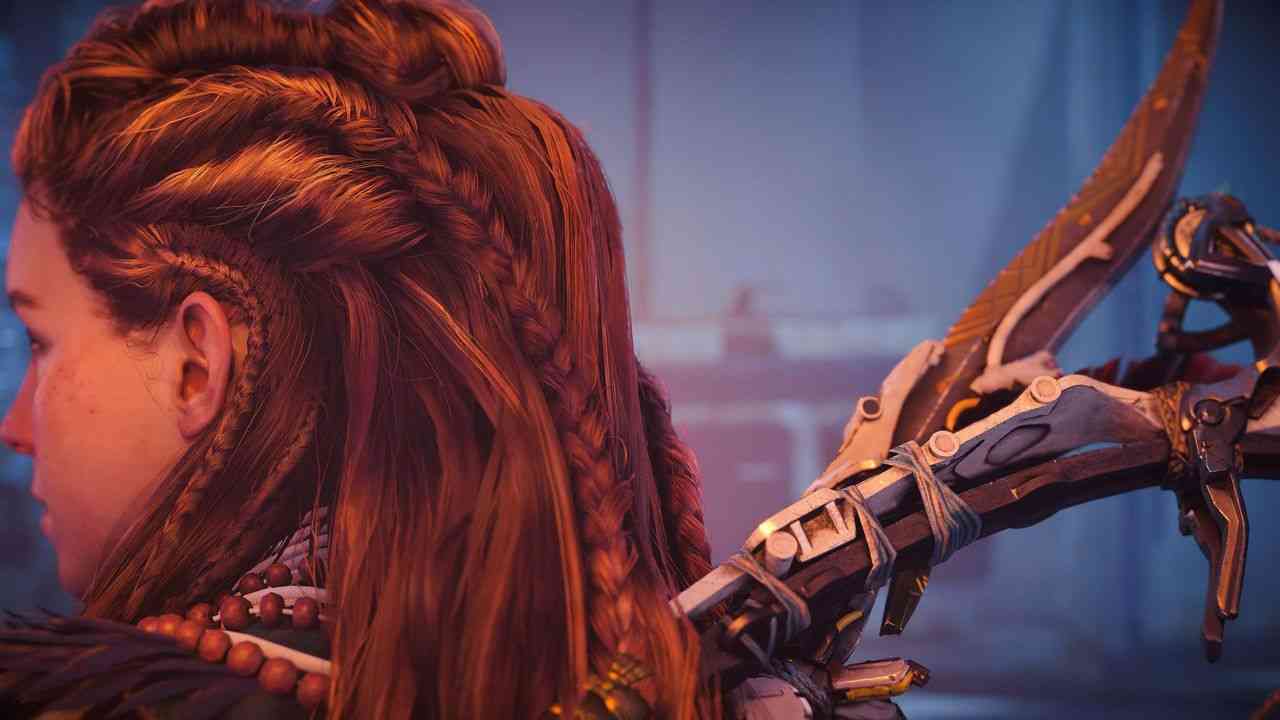
A Visual Masterpiece
Also, wow, the machines are meticulously detailed and well constructed. Each has weak points and armor plating that makes sense for the creature it’s based on, all of it completely dynamic and believable. I spent a lot of time in photo mode zoomed all the way in on machines, people, and environments just to take in the unbelievable level of detail and material quality in Forbidden West.
Visually – especially on the PS5 – Horizon Forbidden West is jaw dropping. The art alone is enough to make a graphics nerd’s hands get clammy. Combined with the technical precision on display, Guerrilla has produced an absurd level of fidelity. Yet more impressive is how they’ve managed to scale the experience to run stably on the original PS4, albeit at a much lower resolution and without many of the most impressive effects.
Cutscenes in particular look incredible. Aloy and the other characters look outstanding, with attention to detail that’s absolutely top tier. Aloy’s skin looks, frankly, real. Her cheeks are subtly windburned, a result of her months in the wilderness, while the fur around Varl’s collar looks… like fur. It’s a scary level of realism, and a lot of that has to do with the lighting model that’s in play.
It’s cinematic and atmospheric, and works to enhance the characters and landscapes that are being lit up. So many open world games with dynamic time of day get that utterly wrong, and they should be looking at Forbidden West to try and copy that system. Vistas and overlooks are designed for that jaw drop moment, and it still hasn’t gotten old. Fog settles into low lying areas up in the mountains, with the light scattering believably. Surfaces are similarly affected by the light, reflecting and diffusing just as a real surface would.
It’s a shame that ray tracing didn’t fit into the equation on PS5, though. Reflections appear to be mostly screen space based, and it’s one area where things can fall apart as a character near to the camera effects the reflection of distant objects and terrain. Perhaps in a future update or DLC, Guerrilla?
On the animation side, things are mostly outstanding. I’m not sure if they did facial capture for every scene and minute side mission in the game, but it looks like they did in most cases. Characters emote and react well, and the lip synching is as close to perfect as I’ve seen. I say mostly outstanding because things don’t always work flawlessly. Aloy’s hair is a bit overactive for my taste, sliding back and forth over her shoulder like it’s coated in teflon. In a few scenes (even with the day one patch), facial expressions didn’t seem to play correctly. Particularly after a camera cut, I noticed a few times where Aloy’s face was her neutral expression despite the gravity and emotional nature of the situation. I’m sure this will continue to be ironed out in coming patches, and to be absolutely clear, this problem cropped up in probably less than 1% of scenes.
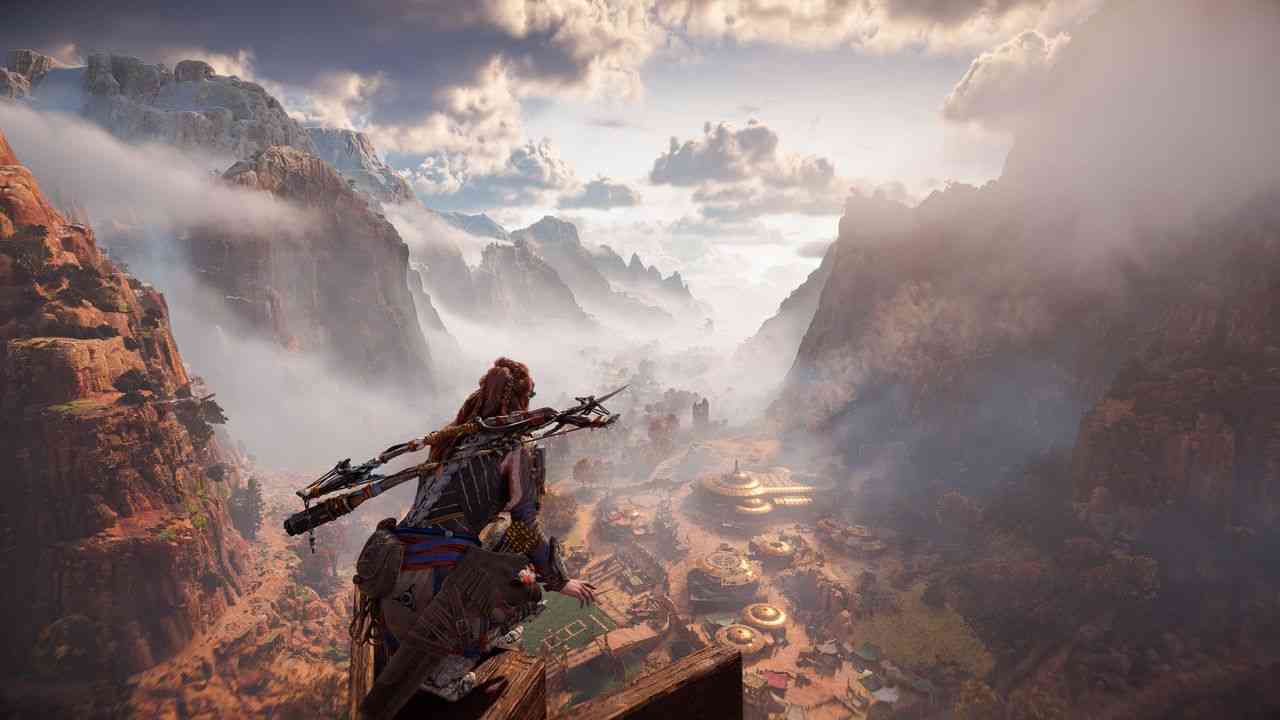
Bugs? Yes. Problem? Not really.
There are definitely other bugs in the release version of the game. It’s definitely expected in a game of this scale and scope, but there are few things you’ll certainly notice. Occasionally, the game will fade to black for a second and fade back up if you’re traversing a big distance quickly, though this issue is far rarer with the day one patch applied. I also had a few hard game crashes during my time, but again, things have been smooth since the day one patch. The one thing that hasn’t improved with the day one patch is some sudden loading of assets. There were a few times that a tower or wall would suddenly pop into view as I approached, hiding the already loaded interior contents of the structure.
Thankfully, outside of what’s mentioned above there were no progression or gameplay related bugs in my time with the game. Granted, my 52 hours played as of this writing only equated to 44% completion, so your mileage may vary depending on what content you check out peripheral to the main story.
I’ll also briefly touch on the performance modes for the PS5 version of the game. I preferred the 30fps resolution priority mode personally. On a 4k screen, the resolution is far higher than in performance mode, and it gave me the cinematic experience I was looking for without noticeably affecting the level of control I had during combat and exploration. I did notice what I assume is some dynamic resolution scaling, and in busy scenes you’re liable to see a few jagged edges scattered around. In performance mode a solid 60fps is achieved, but in swapping between the two I felt like the performance mode smeared a layer of grease over the world I didn’t love. In all, both modes perform basically as advertised.
So while Horizon Forbidden West isn’t changing the rules of the genre, it’s an excellently crafted, entertaining, and satisfying adventure. It looks phenomenal and offers a sandbox of gameplay that remains just as unique as the original. Is it more of the same? In a way, I suppose. But I know I wouldn’t say no to more of Horizon Zero Dawn as it was 5 years ago, and Forbidden West is an improvement in nearly every way.
*Review copy provided by the publisher*
The Good
- Absolutely stunning
- Fun and varied combat
- An improvement in nearly every way over its predecessor
The Bad
- Open world jank
- A few non-gameplay bugs
